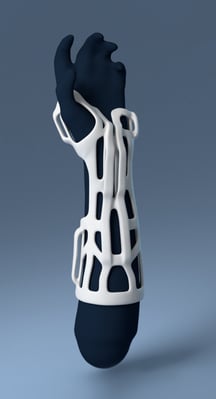Distal Radius Fracture
A distal radius fracture is one of the most common types of fractures. Depending on some factors, the treatment will be non-surgical or surgical. In any case, the application of an orthosis will regulate comfort and pain control.
After surgery treatment, according to the protocol, patients will wear a cast for up to two weeks until the first check-up. At this point, the cast can be replaced with a removable orthosis to wear for at least four more weeks. This is where our popular A1 model comes into the picture.
The A1 model (see picture) is one of the most designed models in the Spentys Application. The A1 model is frequently used to treat a post-operative distal radius fracture.
The A1 model provides support and comfort but ultimately maintains the immobilization of the operated wrist while preserving finger movement.
 |
 |
 |
Printer and materials
We recommend printing the A1 model for immobilization of the wrist using a sturdier material (semi-rigid to rigid). The most popular printing technique and material combination is FDM-PP. PP has semi-flexible, fatigue-resistant, chemical-resistant and thermoformable properties.
We recommend the following settings for printing the A1 with FDM-PP:
- A global thickness of 4mm – thickness of 3mm will be too thin for providing enough firmness to the orthosis, keeping the pathology in mind. A thickness of 5mm will be too rigid to don the orthosis. It will not be possible to deform the orthosis to make it easier to put on.
- Dorsal opening. Keep the dorsal opening wide enough so the patient can easily don the orthosis. Sturdier material will be more difficult to held open when putting on the orthosis.
- Offset. To preserve a better healing of the operation wound, you can add a local offset at the region, so the orthosis won’t touch the wound. Another option is to create a larger alveolus around the scar, without any local offset so the limb will be fully supported by the orthosis.
 |
 |
Another option is MJF-TPU. In general, TPU is more flexible than PP. That’s why we do not recommend using MJF-TPU to treat a distal radius fracture.
The last option is DLP-ST45, which is a bit sturdier than FDM-PP. ST45 has biocompatible; high details; high strength, toughness, impact resistance; fast printing as properties. This is still a R&D project of Spentys, further info about the technique and material will follow.